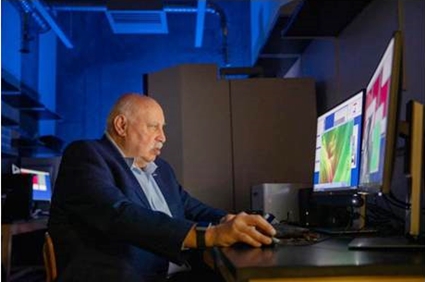|
NOVIDADES
One of the most challenging aspects of the COVID-19 pandemic has been the lack of testing needed to detect and trace infections. Many tests use biochemicals that can be expensive and difficult to produce. These tests can require long turnaround times for test results and can produce a high number of false negative results. A Northern Arizona University (NAU) research team, led by professor Miguel José Yacamán, is developing a new test technology for SARS-CoV-2 using single-molecule surface-enhanced Raman spectroscopy (SM-SERS). The researchers are applying concepts from the fields of nanotechnology, plasmonics, and 2D materials to their development process. “The project team will use nontraditional techniques to detect virus in infected patients,” Yacamán said. “We will develop an alternative method based on recent advances in physics related to the interaction of light with matter.”  NAU physicist and materials scientist Miguel José Yacamán is leading an interdisciplinary team to develop a new test technology for the coronavirus that is based on physics, not biochemicals, that could overcome the challenges presented by current shortages of test kits and test efficacy. Courtesy of Northern Arizona University.
Yacamán believes that his team’s research into SARS-CoV-2 testing could be the first step in developing a physics-based testing approach that would be fast and inexpensive, provide high sensitivity and specificity, and deliver a low percentage of false negatives. “This test will be a much more precise and reliable method to detect infections,” he said. Once the test is developed, portable Raman equipment could allow the test to be used widely in many different populations — for example, in rural or remote communities or in point-of-care stations in schools, factories, and community centers, in addition to traditional testing sites. The project is a joint effort between researchers in the Center for Materials Interfaces in Research and Applications (¡MIRA!), who will develop the new testing technology, and scientists in the Pathogen and Microbiome Institute (PMI), who will grow the SARS-CoV-2 virus in their labs. The project, called “Development of a New Test for SARS-CoV-2 Using Single Molecule Surface Enhanced Raman Spectroscopy,” was awarded a $200,000 grant from the National Science Foundation’s Rapid Response Research (RAPID) funding program supporting virus-related research. Although the team has one year to develop the new test, Yacamán plans to achieve this goal sooner. “Once widespread testing is underway, further analysis of the SM-SERS data will help scientists understand changes on the virus proteins and help develop antiviral drugs,” he said. PhotonicsMedia. Posted: May 23, 2020.
|
|||||||||||||||||||||||||